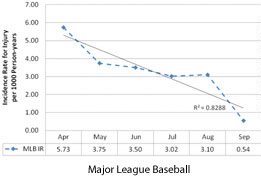Mission Critical: The Winter On-Ramp for Pitchers
The Winter is often an overlooked time of the year for training and preparation, particularly with pitchers. Many youth and college pitchers think of the Winter as the time to take time off and not throw. But this mindset and thought process is not accurate and resting during the Winter is not only misguided, but could be dangerous for arm health. There is a large amount of objective data out there that signals towards using the Winter to train and build the foundation that needs to be set to avoid injury once the competitive Spring season arrives.
Why Is The Winter So Important To Throwers?
On average, 70% of arm injuries over the course of the Major League Baseball season happens in the first 2 months of the season. The month with the lowest rate of arm injuries in pitchers is September, the last month of the regular season. Common thinking is that pitch counts and overuse are the most likely culprits in arm injuries, but these objective facts signal towards a whole different set of reasons that arm injuries occur… not being physically prepared for the stress that the Spring season brings. Whether the pitcher is in high school, college, or professional baseball, the transition from Winter training to full-time baseball practice can be extreme. Nothing can replicate the stress of a full week of practices and competitive situations, but the Winter should be used to prepare the pitcher’s body and arm for that stress as much as possible because because the data signals that a physical breakdown early in the Spring season is the reason for most arm injuries. So while the MLB Pitch Smart Guidelines are well intentioned for young pitchers, the real issue is something much more nuanced and grounded in reality… participating in a structured and logical Winter training program that prepares the pitcher for the stress and rigors of the competitive season.

How The Winter Training Setup Should Look
Arm Care for pitchers is nuanced and contextual, so there is no one-size-fits-all approach. We published a guide on how to simplify arm care, but there is always going to be a degree of individualization that needs to be accounted for. There are several phases that a proper Winter training schedule should follow…
- De-Load – it is important that pitchers find time in the calendar to go through a phase of low intent or no throwing. This allows the soft tissue and supporting structures to relax, recover, and regenerate to get back to a baseline level. This de-load phase can vary dramatically between ages, levels, and individuals… some might take weeks off completely from throwing, while some (especially older pitchers) might just want to dramatically lower their intent for a phase. No matter the level of the de-load, the concept and importance behind it is of critical importance to pitchers. At KPI we aim to use the last 2-3 weeks of October as our de-load phase.
- On-Ramp – The on-ramp phase is critical in gradually building up the pitcher for the Spring season. Although we use an official 4 week on-ramp (month of November), the whole Winter can be viewed as one, long on-ramp to prepare for the Spring. The on-ramp should start slow (3 days/week) and very gradually add in stress through increased volume and intent. This allows the soft tissue to gradually respond to the stress and adapt to get stronger, exactly what it should be doing. When too much stress is introduced and the soft tissue is not prepared for those levels of stress, it will break down somewhere or start accumulating the wear and tear that eventually will cause a break down.
- Pitch Design/Command Phase – As we are building up pitchers at different times in the year we like to blend in pitch design and command work while the pitchers are at the lower intent levels in their throwing. This gives the pitchers important facets to focus on while their velocity is still constrained. We use pitch design focus’ in many ways, outlined in this presentation (passcode ^$d+d22+). Throwing at the lower intent levels allows the pitcher to focus on their movement patterns and other metrics that will be more and more important as the pitcher reaches higher intent. We are always tracking command with our various charting methods, but pitchers are more apt to pay attention and learn from command reports when their velocity is not at full throttle.
- Velocity Phase – After 4-6 weeks of on-ramp in the Winter we start the pitchers in a velocity phase. The velocity phase is definitely still an on-ramp, but we start to gradually introduce 100% intent and higher levels of stress to prepare the arm and body for competitive situations. During the velocity phase we track the velocity of all drills, pulldowns, and pitches. The pitchers use different size and weighted balls to increase proprioception and we are able to use our formulas to identify weaknesses in their throwing and we adjust programming accordingly. By the end of the velocity phase we typically see a 3+ mph gain in Fastball command. This linked information sheet displays our results from last Winter’s velocity phase.
- Live AB’s – After 4-6 weeks of the velocity phase the soft tissue is usually ready for the next level of stimulus, adding in the adrenaline of facing Live Batters. This causes a much different stress reaction in the body and pitchers will often get way more sore throwing live than throwing bullpens with much more volume. We usually do 2-3 weeks of Live AB’s before the pitcher’s start date of their Spring season. This ensures that we hand the pitcher’s off to their high school, college, or professional teams completely prepared to handle the stress that the competitive season will challenge them with and mitigate their chance of injury as much as possible. Our goal is to have the pitchers at 50-pitch high intent baseline when we hand them off to their Spring teams.

Conclusion
Winter is not time to “shut down” and it is not time to take it easy for high level pitchers. The weeks and months leading up to the Spring season are the most critical in building the foundation needed to handle the rigors of the competitive Spring season. We have had incredible success in maintaining health in our pitchers and our approach to Winter training and throwing is the main reason why. The proof is in the numbers… let those guide the plan.


